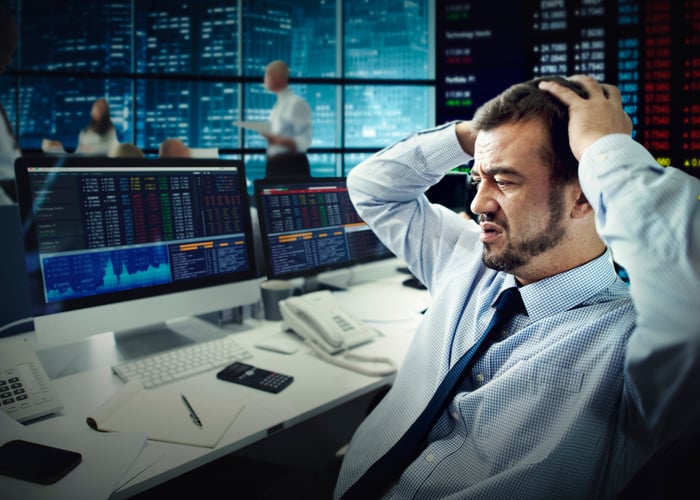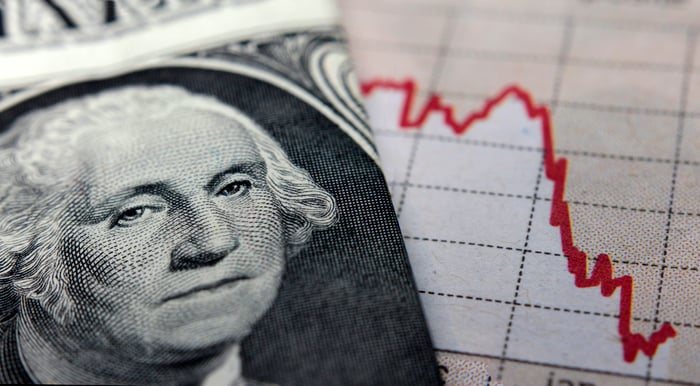To be perfectly blunt, this has been an abysmal year for Wall Street. The benchmark S&P 500 (^GSPC -0.88%) delivered its worst first-half performance to a year since 1970. We've also witnessed the index that led Wall Street higher following the coronavirus crash in 2020, the Nasdaq Composite (^IXIC -2.05%), plummet as much as 34% since November.
The impetus for these moves includes historically high inflation, which hit a wallet-thumping 9.1% in June 2022, Russia's invasion of Ukraine, which is further crippling global energy supply chains, and the Federal Reserve's aggressive monetary policy shift. The Fed has raised its federal funds target rate by 75 basis points in back-to-back meetings.
Now, we can add a new catalyst to the list: A "recession" ... sort of.

Image source: Getty Images.
Are we in a recession? It really depends on your school of thought
For many investors, there's a broad-scope definition of what a recession is that's become accepted. If U.S. gross domestic product (GDP) retraces for two consecutive quarters, the widely held belief is that the U.S. economy is in a recession.
In late June, the Bureau of Economy Analysis (BEA) released its final estimate for first-quarter U.S. GDP, which showed a 1.6% decline. On Thursday, July 28, 2022, the BEA released its advanced estimate (basically its first early look) at U.S. second-quarter GDP, which showed a 0.9% retracement. Cross the "T's" and dot the "I's," and it sure looks like a recession for the U.S. economy.
However, there's technically more to a recession than just two consecutive quarters of GDP declines. Officially, an eight-economist committee that's part of the National Bureau of Economic Research (NBER) decides if a recession is occurring or not. While GDP is one of the factors considered, this committee also takes into account consumer spending, retail sales, employment data (both nonfarm payroll employment and household surveys), personal income, and industrial production. The NBER is the official arbiter of whether the U.S. is in a recession.
For example, both retail sales and the employment data fail to paint a picture of the U.S. in a recession. The Commerce Department noted in its press release in mid-July that retail sales rose 1% in June, and declined by a revised 0.1% in May. This would suggest that consumers are still freely spending. Then again, with the prices for goods and services skyrocketing, what choice do consumers have but to open their wallets a bit wider?
The U.S. unemployment rate is also historically low -- 3.6% in June 2022. Normally we'd see evidence of job losses and a rising unemployment rate during a recession.

Image source: Getty Images.
Wall Street has much more to worry about than whether or not we're in a "recession"
While the "R" word (recession) is usually enough to shake Wall Street's confidence, there's a far greater concern that's front-and-center and fully capable of taking the S&P 500 and Nasdaq Composite a lot lower. I'm talking about the Shiller price-to-earnings (P/E) ratio.
I'm guessing most investors are relatively familiar with the P/E ratio. You take the share price of a publicly traded company's stock and divide it into that company's earnings per share over the trailing-12-month period. The P/E ratio is a valuation tool that can be used to compare against similar companies or perhaps the broader market to determine if a stock is "cheap" or "expensive."
The Shiller P/E ratio, which is also known as the cyclically adjusted price-to-earnings ratio (CAPE ratio), takes into account inflation-adjusted earnings over the past 10 years. It's a more encompassing look at where the broader market -- specifically, the S&P 500 -- has headed over the past decade from a valuation perspective.
Here's the interesting thing about the S&P 500's Shiller P/E ratio: Bad things happen when it's above 30.
Dating all the way back to 1870, the average Shiller P/E ratio is 16.96. As of this writing on July 29, 2022, it's sitting at 30.55. But it's not just the current value that's alarming. It's what's happened each previous time the Shiller P/E surpassed 30, as well as what the earnings outlook (the "e" component) has in store for many of Wall Street's most-important businesses.
Since 1870, there have only been five instances where the S&P 500's Shiller P/E ratio surpassed and held above 30:
- 1929: The Great Depression led the Dow Jones Industrial Average (^DJI 0.56%) to lose nearly 90% of its value.
- 1997-2001: The S&P 500 Shiller P/E hit its all-time high above 44 during the dot-com boom. Eventually, the S&P 500 would lose almost half its value.
- Q3 2018: During the third quarter of 2018, the Shiller P/E ratio, again, pushed above 30. The S&P 500 lost 20% of its value in the subsequent quarter.
- Q4 2019-Q1 2020: The S&P Shiller P/E ratio's next trek above 30 was thwarted by the COVID-19 crash, which cost the S&P 500 34% of its value in 33 calendar days.
- Q3 2020-current: In January 2022, the S&P 500 Shiller P/E peaked just above 40. Since then, the S&P 500 and Nasdaq Composite both entered bear market territory.
Although ease-of-access to information has made the investing community more tolerant of risk-taking and higher P/E ratios over time, history has been pretty clear that bad things happen when the S&P 500 Shiller P/E is above 30 (as it is now).
To make matters worse, a flurry of earnings reports have shown that the "E" component in earnings is worsening. With a number of influential publicly traded companies missing Wall Street's second-quarter expectations or delivering tepid growth outlooks for the third quarter or remainder of the year, the Shiller P/E could potentially increase.
While valuation alone is rarely enough to send the stock market lower, the tea leaves say this is the data point you shouldn't ignore.




